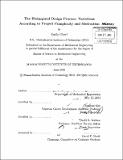| dc.contributor.advisor | Sangbae Kim and David R. Wallace. | en_US |
| dc.contributor.author | Obert, Emily | en_US |
| dc.contributor.other | Massachusetts Institute of Technology. Department of Mechanical Engineering. | en_US |
| dc.date.accessioned | 2013-10-24T17:35:45Z | |
| dc.date.available | 2013-10-24T17:35:45Z | |
| dc.date.copyright | 2013 | en_US |
| dc.date.issued | 2013 | en_US |
| dc.identifier.uri | http://hdl.handle.net/1721.1/81619 | |
| dc.description | Thesis (S.M.)--Massachusetts Institute of Technology, Dept. of Mechanical Engineering, 2013. | en_US |
| dc.description | Cataloged from PDF version of thesis. | en_US |
| dc.description | Includes bibliographical references (p. 51-53). | en_US |
| dc.description.abstract | Taking cues from natural creatures and systems is becoming a more widely used technique in engineering design. This design philosophy or technique is referred to as bioinspired design or biomimicry. Prior art has focused on problem-driven and solution-based bioinspired process without reflection upon the nature of the engineering challenges to which the technique is being applied, or the motives for applying this design philosophy. After interviewing nine researchers from six different laboratories at MIT about bioinspired design projects and processes, some commonalities and differences in bioinspired design process were observed. This thesis generalizes these observations to propose four unique bioinspired design processes, each tailored to one of the following: problem-driven low-complexity systems, problem-driven complex systems, inspiration-driven low-complexity systems and inspiration-driven complex systems. The steps of visualization, data extraction, modeling, optimization, design and fabrication are detailed, with the aim of guiding designers away from commonly encountered problems. Additionally, it was found that relationships between biologists and engineers can be strained by differing goals, timelines and vocabulary, but that engineers applying bioinspired design techniques find these relationships to be valuable and seek to strengthen them. | en_US |
| dc.description.statementofresponsibility | by Emily Obert. | en_US |
| dc.format.extent | 53 p. | en_US |
| dc.language.iso | eng | en_US |
| dc.publisher | Massachusetts Institute of Technology | en_US |
| dc.rights | M.I.T. theses are protected by
copyright. They may be viewed from this source for any purpose, but
reproduction or distribution in any format is prohibited without written
permission. See provided URL for inquiries about permission. | en_US |
| dc.rights.uri | http://dspace.mit.edu/handle/1721.1/7582 | en_US |
| dc.subject | Mechanical Engineering. | en_US |
| dc.title | The bioinspired design process : according to project complexity and motivation | en_US |
| dc.type | Thesis | en_US |
| dc.description.degree | S.M. | en_US |
| dc.contributor.department | Massachusetts Institute of Technology. Department of Mechanical Engineering | |
| dc.identifier.oclc | 859149498 | en_US |
